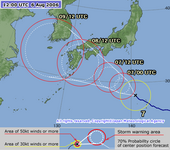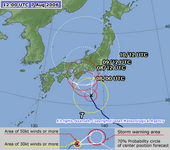2006年08月09日 18:00 JST
|
2006-08-05 2100 JST |
2006-08-06 2100 JST |
2006-08-07 2100 JST |
2006-08-08 2100 JST |
|---|---|---|---|

|

|

|

|
2006年08月09日 07:30 JST
台風7号(MARIA)は東に向きを変えて本州沿いをゆっくりと進んでいます。中心付近にはあまり雨雲がなく、最も強い雨雲はすでに関東地方にかかっています。
2006年08月08日 07:30 JST
台風7号(MARIA)は徐々に台風8号から離れ、北上のあとさらに東に向きを変えるという予報になりました。上陸を目前にして台風の動きは複雑になっています。勢力はやや衰えつつありますが、強い雨雲が台風の北東側に発生しており、これがすでに静岡県・伊豆諸島・関東地方にかかりつつあります。
2006年08月07日 22:30 JST
台風7号(MARIA)はここに来て進路が北向きに変わってきました。上陸の可能性が最も高い地点は、今朝は四国でしたが現在は紀伊半島〜東海地方へとだいぶ東側にシフトしています。この動きの変化もあるいは台風の干渉の影響かもしれません。
- 台風200607号・台風200608号・台風200609号
- 3台風重心動画 :: MPEG-2
2006年08月07日 05:30 JST
台風7号(MARIA)は予報進路がやや北向きに変わりつつあり、四国を中心に九州や本州に上陸する可能性が高まっています。
2006年08月06日 17:15 JST
台風7号(MARIA)は渦の巻きも強くなり、着実に発達しつつあります。台風9号の発生によって、いよいよ太平洋には3個の台風が並ぶことになり、予報が難しい状況となってきました。
2006年08月06日 01:30 JST
台風7号(MARIA)が小笠原近海で発生しました。まだそれほど発達した台風ではありませんが、父島には早くも明朝には接近するという予報となっておりますので、小笠原諸島では影響が出てくるかもしれません。
リンク集
-
EO Natural Hazards: Typhoon Maria
台風MARIAの衛星画像(NASA)。
http://earthobservatory.nasa.gov/NaturalHazards/natural_hazards_v2.php3?img_id=13758
関連する台風ブログ記事
2025
2024
- 2024年台風のまとめ
- 2024年台風26号(パブーク|PABUK)
- 2024年台風25号(ウサギ|USAGI)
- 2024年台風24号(マンニィ|MAN-YI)
- 2024年台風23号(トラジー|TORAJI)
- 2024年台風22号(インシン|YINXING)
- 2024年台風21号(コンレイ|KONG-REY)
- 2024年台風20号(チャーミー|TRAMI)
- 2024年台風19号(バリジャット|BARIJAT)
- 2024年台風18号(クラトーン|KRATHON)
- 2024年台風17号(チェービー|JEBI)
- 2024年台風16号(シマロン|CIMARON)
- 2024年台風15号(ソーリック|SOULIK)
- 2024年台風14号(プラサン|PULASAN)
- 2024年台風13号(バビンカ|BEBINCA)
- 2024年台風12号(リーピ|LEEPI)
- 2024年台風11号(ヤギ|YAGI)
- 2024年台風10号(サンサン|SHANSHAN)
- 2024年台風9号(ジョンダリ|JONGDARI)
- 2024年台風8号(ウーコン|WUKONG)
- 2024年台風7号(アンピル|AMPIL)
- 2024年台風6号(ソンティン|SON-TINH)
- 2024年台風5号(マリア|MARIA)
- 2024年台風4号(プラピルーン|PRAPIROON)
- 2024年台風3号(ケーミー|GAEMI)
- 2024年台風2号(マリクシ|MALIKSI)
- 2024年台風1号(イーウィニャ|EWINIAR)
2023
- 2023年台風のまとめ
- 2023年台風17号(ジェラワット|JELAWAT)
- 2023年台風16号(サンバ|SANBA)
- 2023年台風15号(ボラヴェン|BOLAVEN)
- 2023年台風14号(コイヌ|KOINU)
- 2023年台風13号(インニョン|YUN-YEUNG)
- 2023年台風12号(キロギー|KIROGI)
- 2023年台風11号(ハイクイ|HAIKUI)
- 2023年台風10号(ダムレイ|DAMREY)
- 2023年台風9号(サオラー|SAOLA)
- 2023年台風8号(ドーラ|DORA)
- 2023年台風7号(ラン|LAN)
- 2023年台風6号(カーヌン|KHANUN)
- 2023年台風5号(トクスリ|DOKSURI)
- 2023年台風4号(タリム|TALIM)
- 2023年台風3号(グチョル|GUCHOL)
- 2023年台風2号(マーワー|MAWAR)
- 2023年台風1号(サンヴー|SANVU)
2022
- 2022年台風のまとめ
- 2022年台風25号(パカー|PAKHAR)
- 2022年台風24号(ヤマネコ|YAMANEKO)
- 2022年台風23号(バンヤン|BANYAN)
- 2022年台風22号(ナルガエ|NALGAE)
- 2022年台風21号(ハイタン|HAITANG)
- 2022年台風20号(ネサット|NESAT)
- 2022年台風19号(ソンカー|SONCA)
- 2022年台風18号(ロウキー|ROKE)
- 2022年台風17号(クラー|KULAP)
- 2022年台風16号(ノルー|NORU)
- 2022年台風15号(タラス|TALAS)
- 2022年台風14号(ナンマドル|NANMADOL)
- 2022年台風13号(マールボック|MERBOK)
- 2022年台風12号(ムイファー|MUIFA)
- 2022年台風11号(ヒンナムノー|HINNAMNOR)
- 2022年台風10号(トカゲ|TOKAGE)
- 2022年台風9号(マーゴン|MA-ON)
- 2022年台風8号(メアリー|MEARI)
- 2022年台風7号(ムーラン|MULAN)
- 2022年台風6号(トローセス|TRASES)
- 2022年台風5号(ソングダー|SONGDA)
- 2022年台風4号(アイレー|AERE)
- 2022年台風3号(チャバ|CHABA)
- 2022年台風2号(メーギー|MEGI)
- 2022年台風1号(マラカス|MALAKAS)
2021
- 2021年台風のまとめ
- 2021年台風22号(ライ|RAI)
- 2021年台風21号(ニヤトー|NYATOH)
- 2021年台風20号(マーロウ|MALOU)
- 2021年台風19号(ナムセーウン|NAMTHEUN)
- 2021年台風18号(コンパス|KOMPASU)
- 2021年台風17号(ライオンロック|LIONROCK)
- 2021年台風16号(ミンドゥル|MINDULLE)
- 2021年台風15号(ディアンムー|DIANMU)
- 2021年台風14号(チャンスー|CHANTHU)
- 2021年台風13号(コンソン|CONSON)
- 2021年台風12号(オーマイス|OMAIS)
- 2021年台風11号(ニーダ|NIDA)
- 2021年台風10号(ミリネ|MIRINAE)
- 2021年台風9号(ルピート|LUPIT)
- 2021年台風8号(ニパルタック|NEPARTAK)
- 2021年台風7号(チャンパカ|CEMPAKA)
- 2021年台風6号(インファ|IN-FA)
- 2021年台風5号(チャンパー|CHAMPI)
- 2021年台風4号(コグマ|KOGUMA)
- 2021年台風3号(チョーイワン|CHOI-WAN)
- 2021年台風2号(スリゲ|SURIGAE)
- 2021年台風1号(ドゥージェン|DUJUAN)
2020
- 2020年台風のまとめ
- 2020年台風23号(クロヴァン|KROVANH)
- 2020年台風22号(ヴァムコー|VAMCO)
- 2020年台風21号(アータウ|ETAU)
- 2020年台風20号(アッサニー|ATSANI)
- 2020年台風19号(コーニー|GONI)
- 2020年台風18号(モラヴェ|MOLAVE)
- 2020年台風17号(ソウデル|SAUDEL)
- 2020年台風16号(ナンカー|NANGKA)
- 2020年台風15号(リンファ|LINFA)
- 2020年台風14号(チャンホン|CHAN-HOM)
- 2020年台風13号(クジラ|KUJIRA)
- 2020年台風12号(ドルフィン|DOLPHIN)
- 2020年台風11号(ノウル|NOUL)
- 2020年台風10号(ハイシェン|HAISHEN)
- 2020年台風9号(メイサーク|MAYSAK)
- 2020年台風8号(バービー|BAVI)
- 2020年台風7号(ヒーゴス|HIGOS)
- 2020年台風6号(メーカラー|MEKKHALA)
- 2020年台風5号(チャンミー|JANGMI)
- 2020年台風4号(ハグピート|HAGUPIT)
- 2020年台風3号(シンラコウ|SINLAKU)
- 2020年台風2号(ヌーリ|NURI)
- 2020年台風1号(ヴォンフォン|VONGFONG)
2019
- 2019年台風のまとめ
- 2019年台風29号(ファンフォン|PHANFONE)
- 2019年台風28号(カンムリ|KAMMURI)
- 2019年台風27号(フォンウォン|FUNG-WONG)
- 2019年台風26号(カルマエギ|KALMAEGI)
- 2019年台風25号(フンシェン|FENGSHEN)
- 2019年台風24号(ナクリー|NAKRI)
- 2019年台風23号(ハーロン|HALONG)
- 2019年台風22号(マットゥモ|MATMO)
- 2019年台風21号(ブアローイ|BUALOI)
- 2019年台風20号(ノグリー|NEOGURI)
- 2019年台風19号(ハギビス|HAGIBIS)
- 2019年台風18号(ミートク|MITAG)
- 2019年台風17号(ターファー|TAPAH)
- 2019年台風16号(ペイパー|PEIPAH)
- 2019年台風15号(ファクサイ|FAXAI)
- 2019年台風14号(カジキ|KAJIKI)
- 2019年台風13号(レンレン|LINGLING)
- 2019年台風12号(ポードル|PODUL)
- 2019年台風11号(バイルー|BAILU)
- 2019年台風10号(クローサ|KROSA)
- 2019年台風9号(レキマー|LEKIMA)
- 2019年台風8号(フランシスコ|FRANCISCO)
- 2019年台風7号(ウィパー|WIPHA)
- 2019年台風6号(ナーリー|NARI)
- 2019年台風5号(ダナス|DANAS)
- 2019年台風4号(ムーン|MUN)
- 2019年台風3号(セーパット|SEPAT)
- 2019年台風2号(ウーティップ|WUTIP)
- 2019年台風1号(パブーク|PABUK)
2018
- 2018年台風のまとめ
- 2018年台風29号(ウサギ|USAGI)
- 2018年台風28号(マンニィ|MAN-YI)
- 2018年台風27号(トラジー|TORAJI)
- 2018年台風26号(イートゥー|YUTU)
- 2018年台風25号(コンレイ|KONG-REY)
- 2018年台風24号(チャーミー|TRAMI)
- 2018年台風23号(バリジャット|BARIJAT)
- 2018年台風22号(マンクット|MANGKHUT)
- 2018年台風21号(チェービー|JEBI)
- 2018年台風20号(シマロン|CIMARON)
- 2018年台風19号(ソーリック|SOULIK)
- 2018年台風18号(ルンビア|RUMBIA)
- 2018年台風17号(ヘクター|HECTOR)
- 2018年台風16号(バビンカ|BEBINCA)
- 2018年台風15号(リーピ|LEEPI)
- 2018年台風14号(ヤギ|YAGI)
- 2018年台風13号(サンサン|SHANSHAN)
- 2018年台風12号(ジョンダリ|JONGDARI)
- 2018年台風11号(ウーコン|WUKONG)
- 2018年台風10号(アンピル|AMPIL)
- 2018年台風9号(ソンティン|SON-TINH)
- 2018年台風8号(マリア|MARIA)
- 2018年台風7号(プラピルーン|PRAPIROON)
- 2018年台風6号(ケーミー|GAEMI)
- 2018年台風5号(マリクシ|MALIKSI)
- 2018年台風4号(イーウィニャ|EWINIAR)
- 2018年台風3号(ジェラワット|JELAWAT)
- 2018年台風2号(サンバ|SANBA)
- 2018年台風1号(ボラヴェン|BOLAVEN)
2017
- 2017年台風のまとめ
- 2017年台風27号(テンビン|TEMBIN)
- 2017年台風26号(カイタク|KAI-TAK)
- 2017年台風25号(キロギー|KIROGI)
- 2017年台風24号(ハイクイ|HAIKUI)
- 2017年台風23号(ダムレイ|DAMREY)
- 2017年台風22号(サオラー|SAOLA)
- 2017年台風21号(ラン|LAN)
- 2017年台風20号(カーヌン|KHANUN)
- 2017年台風19号(トクスリ|DOKSURI)
- 2017年台風18号(タリム|TALIM)
- 2017年台風17号(グチョル|GUCHOL)
- 2017年台風16号(マーワー|MAWAR)
- 2017年台風15号(サンヴー|SANVU)
- 2017年台風14号(パカー|PAKHAR)
- 2017年台風13号(ハト|HATO)
- 2017年台風12号(バンヤン|BANYAN)
- 2017年台風11号(ナルガエ|NALGAE)
- 2017年台風10号(ハイタン|HAITANG)
- 2017年台風9号(ネサット|NESAT)
- 2017年台風8号(ソンカー|SONCA)
- 2017年台風7号(ロウキー|ROKE)
- 2017年台風6号(クラー|KULAP)
- 2017年台風5号(ノルー|NORU)
- 2017年台風4号(タラス|TALAS)
- 2017年台風3号(ナンマドル|NANMADOL)
- 2017年台風2号(マールボック|MERBOK)
- 2017年台風1号(ムイファー|MUIFA)
2016
- 2016年台風のまとめ
- 2016年台風26号(ノックテン|NOCK-TEN)
- 2016年台風25号(トカゲ|TOKAGE)
- 2016年台風24号(マーゴン|MA-ON)
- 2016年台風23号(メアリー|MEARI)
- 2016年台風22号(ハイマー|HAIMA)
- 2016年台風21号(サリカー|SARIKA)
- 2016年台風20号(ソングダー|SONGDA)
- 2016年台風19号(アイレー|AERE)
- 2016年台風18号(チャバ|CHABA)
- 2016年台風17号(メーギー|MEGI)
- 2016年台風16号(マラカス|MALAKAS)
- 2016年台風15号(ライ|RAI)
- 2016年台風14号(ムーランティ|MERANTI)
- 2016年台風13号(マーロウ|MALOU)
- 2016年台風12号(ナムセーウン|NAMTHEUN)
- 2016年台風11号(コンパス|KOMPASU)
- 2016年台風10号(ライオンロック|LIONROCK)
- 2016年台風9号(ミンドゥル|MINDULLE)
- 2016年台風8号(ディアンムー|DIANMU)
- 2016年台風7号(チャンスー|CHANTHU)
- 2016年台風6号(コンソン|CONSON)
- 2016年台風5号(オーマイス|OMAIS)
- 2016年台風4号(ニーダ|NIDA)
- 2016年台風3号(ミリネ|MIRINAE)
- 2016年台風2号(ルピート|LUPIT)
- 2016年台風1号(ニパルタック|NEPARTAK)
2015
- 2015年台風のまとめ
- 2015年台風27号(メーロー|MELOR)
- 2015年台風26号(インファ|IN-FA)
- 2015年台風25号(チャンパー|CHAMPI)
- 2015年台風24号(コップ|KOPPU)
- 2015年台風23号(チョーイワン|CHOI-WAN)
- 2015年台風22号(ムジゲ|MUJIGAE)
- 2015年台風21号(ドゥージェン|DUJUAN)
- 2015年台風20号(クロヴァン|KROVANH)
- 2015年台風19号(ヴァムコー|VAMCO)
- 2015年台風18号(アータウ|ETAU)
- 2015年台風17号(キロ|KILO)
- 2015年台風16号(アッサニー|ATSANI)
- 2015年台風15号(コーニー|GONI)
- 2015年台風14号(モラヴェ|MOLAVE)
- 2015年台風13号(ソウデロア|SOUDELOR)
- 2015年台風12号(ハロラ|HALOLA)
- 2015年台風11号(ナンカー|NANGKA)
- 2015年台風10号(リンファ|LINFA)
- 2015年台風9号(チャンホン|CHAN-HOM)
- 2015年台風8号(クジラ|KUJIRA)
- 2015年台風7号(ドルフィン|DOLPHIN)
- 2015年台風6号(ノウル|NOUL)
- 2015年台風5号(ハイシェン|HAISHEN)
- 2015年台風4号(メイサーク|MAYSAK)
- 2015年台風3号(バービー|BAVI)
- 2015年台風2号(ヒーゴス|HIGOS)
- 2015年台風1号(メーカラー|MEKKHALA)
2014
- 2014年台風のまとめ
- 2014年台風23号(チャンミー|JANGMI)
- 2014年台風22号(ハグピート|HAGUPIT)
- 2014年台風21号(シンラコウ|SINLAKU)
- 2014年台風20号(ヌーリ|NURI)
- 2014年台風19号(ヴォンフォン|VONGFONG)
- 2014年台風18号(ファンフォン|PHANFONE)
- 2014年台風17号(カンムリ|KAMMURI)
- 2014年台風16号(フォンウォン|FUNG-WONG)
- 2014年台風15号(カルマエギ|KALMAEGI)
- 2014年台風14号(フンシェン|FENGSHEN)
- 2014年台風13号(ジェヌヴィーヴ|GENEVIEVE)
- 2014年台風12号(ナクリー|NAKRI)
- 2014年台風11号(ハーロン|HALONG)
- 2014年台風10号(マットゥモ|MATMO)
- 2014年台風9号(ラマスーン|RAMMASUN)
- 2014年台風8号(ノグリー|NEOGURI)
- 2014年台風7号(ハギビス|HAGIBIS)
- 2014年台風6号(ミートク|MITAG)
- 2014年台風5号(ターファー|TAPAH)
- 2014年台風4号(ペイパー|PEIPAH)
- 2014年台風3号(ファクサイ|FAXAI)
- 2014年台風2号(カジキ|KAJIKI)
- 2014年台風1号(レンレン|LINGLING)
2013
- 2013年台風のまとめ
- 2013年台風31号(ポードル|PODUL)
- 2013年台風30号(ハイエン|HAIYAN)
- 2013年台風29号(クローサ|KROSA)
- 2013年台風28号(レキマー|LEKIMA)
- 2013年台風27号(フランシスコ|FRANCISCO)
- 2013年台風26号(ウィパー|WIPHA)
- 2013年台風25号(ナーリー|NARI)
- 2013年台風24号(ダナス|DANAS)
- 2013年台風23号(フィートウ|FITOW)
- 2013年台風22号(セーパット|SEPAT)
- 2013年台風21号(ウーティップ|WUTIP)
- 2013年台風20号(パブーク|PABUK)
- 2013年台風19号(ウサギ|USAGI)
- 2013年台風18号(マンニィ|MAN-YI)
- 2013年台風17号(トラジー|TORAJI)
- 2013年台風16号(イートゥー|YUTU)
- 2013年台風15号(コンレイ|KONG-REY)
- 2013年台風14号(ウナラ|UNALA)
- 2013年台風13号(ペバ|PEWA)
- 2013年台風12号(チャーミー|TRAMI)
- 2013年台風11号(ウトア|UTOR)
- 2013年台風10号(マンクット|MANGKHUT)
- 2013年台風9号(チェービー|JEBI)
- 2013年台風8号(シマロン|CIMARON)
- 2013年台風7号(ソーリック|SOULIK)
- 2013年台風6号(ルンビア|RUMBIA)
- 2013年台風5号(バビンカ|BEBINCA)
- 2013年台風4号(リーピ|LEEPI)
- 2013年台風3号(ヤギ|YAGI)
- 2013年台風2号(サンサン|SHANSHAN)
- 2013年台風1号(ソナムー|SONAMU)
2012
- 2012年台風のまとめ
- 2012年台風25号(ウーコン|WUKONG)
- 2012年台風24号(ボーファ|BOPHA)
- 2012年台風23号(ソンティン|SON-TINH)
- 2012年台風22号(マリア|MARIA)
- 2012年台風21号(プラピルーン|PRAPIROON)
- 2012年台風20号(ケーミー|GAEMI)
- 2012年台風19号(マリクシ|MALIKSI)
- 2012年台風18号(イーウィニャ|EWINIAR)
- 2012年台風17号(ジェラワット|JELAWAT)
- 2012年台風16号(サンバ|SANBA)
- 2012年台風15号(ボラヴェン|BOLAVEN)
- 2012年台風14号(テンビン|TEMBIN)
- 2012年台風13号(カイタク|KAI-TAK)
- 2012年台風12号(キロギー|KIROGI)
- 2012年台風11号(ハイクイ|HAIKUI)
- 2012年台風10号(ダムレイ|DAMREY)
- 2012年台風9号(サオラー|SAOLA)
- 2012年台風8号(ヴェセンティ|VICENTE)
- 2012年台風7号(カーヌン|KHANUN)
- 2012年台風6号(トクスリ|DOKSURI)
- 2012年台風5号(タリム|TALIM)
- 2012年台風4号(グチョル|GUCHOL)
- 2012年台風3号(マーワー|MAWAR)
- 2012年台風2号(サンヴー|SANVU)
- 2012年台風1号(パカー|PAKHAR)
2011
- 2011年台風のまとめ
- 2011年台風21号(ワシ|WASHI)
- 2011年台風20号(バンヤン|BANYAN)
- 2011年台風19号(ナルガエ|NALGAE)
- 2011年台風18号(ハイタン|HAITANG)
- 2011年台風17号(ネサット|NESAT)
- 2011年台風16号(ソンカー|SONCA)
- 2011年台風15号(ロウキー|ROKE)
- 2011年台風14号(クラー|KULAP)
- 2011年台風13号(ノルー|NORU)
- 2011年台風12号(タラス|TALAS)
- 2011年台風11号(ナンマドル|NANMADOL)
- 2011年台風10号(マールボック|MERBOK)
- 2011年台風9号(ムイファー|MUIFA)
- 2011年台風8号(ノックテン|NOCK-TEN)
- 2011年台風7号(トカゲ|TOKAGE)
- 2011年台風6号(マーゴン|MA-ON)
- 2011年台風5号(メアリー|MEARI)
- 2011年台風4号(ハイマー|HAIMA)
- 2011年台風3号(サリカー|SARIKA)
- 2011年台風2号(ソングダー|SONGDA)
- 2011年台風1号(アイレー|AERE)
2010
- 2010年台風のまとめ
- 2010年台風14号(チャバ|CHABA)
- 2010年台風13号(メーギー|MEGI)
- 2010年台風12号(マラカス|MALAKAS)
- 2010年台風11号(ファナピ|FANAPI)
- 2010年台風10号(ムーランティ|MERANTI)
- 2010年台風9号(マーロウ|MALOU)
- 2010年台風8号(ナムセーウン|NAMTHEUN)
- 2010年台風7号(コンパス|KOMPASU)
- 2010年台風6号(ライオンロック|LIONROCK)
- 2010年台風5号(ミンドゥル|MINDULLE)
- 2010年台風4号(ディアンムー|DIANMU)
- 2010年台風3号(チャンスー|CHANTHU)
- 2010年台風2号(コンソン|CONSON)
- 2010年台風1号(オーマイス|OMAIS)
2009
- 2009年台風のまとめ
- 2009年台風22号(ニーダ|NIDA)
- 2009年台風21号(ミリネ|MIRINAE)
- 2009年台風20号(ルピート|LUPIT)
- 2009年台風19号(ニパルタック|NEPARTAK)
- 2009年台風18号(メーロー|MELOR)
- 2009年台風17号(パーマァ|PARMA)
- 2009年台風16号(ケッツァーナ|KETSANA)
- 2009年台風15号(コップ|KOPPU)
- 2009年台風14号(チョーイワン|CHOI-WAN)
- 2009年台風13号(ムジゲ|MUJIGAE)
- 2009年台風12号(ドゥージェン|DUJUAN)
- 2009年台風11号(クロヴァン|KROVANH)
- 2009年台風10号(ヴァムコー|VAMCO)
- 2009年台風9号(アータウ|ETAU)
- 2009年台風8号(モーラコット|MORAKOT)
- 2009年台風7号(コーニー|GONI)
- 2009年台風6号(モラヴェ|MOLAVE)
- 2009年台風5号(ソウデロア|SOUDELOR)
- 2009年台風4号(ナンカー|NANGKA)
- 2009年台風3号(リンファ|LINFA)
- 2009年台風2号(チャンホン|CHAN-HOM)
- 2009年台風1号(クジラ|KUJIRA)
2008
- 2008年台風のまとめ
- 2008年台風22号(ドルフィン|DOLPHIN)
- 2008年台風21号(ノウル|NOUL)
- 2008年台風20号(ハイシェン|HAISHEN)
- 2008年台風19号(メイサーク|MAYSAK)
- 2008年台風18号(バービー|BAVI)
- 2008年台風17号(ヒーゴス|HIGOS)
- 2008年台風16号(メーカラー|MEKKHALA)
- 2008年台風15号(チャンミー|JANGMI)
- 2008年台風14号(ハグピート|HAGUPIT)
- 2008年台風13号(シンラコウ|SINLAKU)
- 2008年台風12号(ヌーリ|NURI)
- 2008年台風11号(ヴォンフォン|VONGFONG)
- 2008年台風10号(ファンフォン|PHANFONE)
- 2008年台風9号(カンムリ|KAMMURI)
- 2008年台風8号(フォンウォン|FUNG-WONG)
- 2008年台風7号(カルマエギ|KALMAEGI)
- 2008年台風6号(フンシェン|FENGSHEN)
- 2008年台風5号(ナクリー|NAKRI)
- 2008年台風4号(ハーロン|HALONG)
- 2008年台風3号(マットゥモ|MATMO)
- 2008年台風2号(ラマスーン|RAMMASUN)
- 2008年台風1号(ノグリー|NEOGURI)
2007
- 2007年台風のまとめ
- 2007年台風24号(ハギビス|HAGIBIS)
- 2007年台風23号(ミートク|MITAG)
- 2007年台風22号(ターファー|TAPAH)
- 2007年台風21号(ペイパー|PEIPAH)
- 2007年台風20号(ファクサイ|FAXAI)
- 2007年台風19号(カジキ|KAJIKI)
- 2007年台風18号(レンレン|LINGLING)
- 2007年台風17号(ポードル|PODUL)
- 2007年台風16号(ハイエン|HAIYAN)
- 2007年台風15号(クローサ|KROSA)
- 2007年台風14号(レキマー|LEKIMA)
- 2007年台風13号(フランシスコ|FRANCISCO)
- 2007年台風12号(ウィパー|WIPHA)
- 2007年台風11号(ナーリー|NARI)
- 2007年台風10号(ダナス|DANAS)
- 2007年台風9号(フィートウ|FITOW)
- 2007年台風8号(セーパット|SEPAT)
- 2007年台風7号(ウーティップ|WUTIP)
- 2007年台風6号(パブーク|PABUK)
- 2007年台風5号(ウサギ|USAGI)
- 2007年台風4号(マンニィ|MAN-YI)
- 2007年台風3号(トラジー|TORAJI)
- 2007年台風2号(イートゥー|YUTU)
- 2007年台風1号(コンレイ|KONG-REY)
2006
- 2006年台風のまとめ
- 2006年台風23号(チャーミー|TRAMI)
- 2006年台風22号(ウトア|UTOR)
- 2006年台風21号(ドリアン|DURIAN)
- 2006年台風20号(チェービー|CHEBI)
- 2006年台風19号(シマロン|CIMARON)
- 2006年台風18号(ソーリック|SOULIK)
- 2006年台風17号(ルンビア|RUMBIA)
- 2006年台風16号(バビンカ|BEBINCA)
- 2006年台風15号(シャンセン|XANGSANE)
- 2006年台風14号(ヤギ|YAGI)
- 2006年台風13号(サンサン|SHANSHAN)
- 2006年台風12号(イオケ|IOKE)
- 2006年台風11号(ソナムー|SONAMU)
- 2006年台風10号(ウーコン|WUKONG)
- 2006年台風9号(ボーファ|BOPHA)
- 2006年台風8号(サオマイ|SAOMAI)
- 2006年台風7号(マリア|MARIA)
- 2006年台風6号(プラピルーン|PRAPIROON)
- 2006年台風5号(ケーミー|KAEMI)
- 2006年台風4号(ビリス|BILIS)
- 2006年台風3号(イーウィニャ|EWINIAR)
- 2006年台風2号(ジェラワット|JELAWAT)
- 2006年台風1号(チャンチー|CHANCHU)
2005
- 2005年台風のまとめ
- 2005年台風23号(ボラヴェン|BOLAVEN)
- 2005年台風22号(テンビン|TEMBIN)
- 2005年台風21号(カイタク|KAI-TAK)
- 2005年台風20号(キロギー|KIROGI)
- 2005年台風19号(ロンワン|LONGWANG)
- 2005年台風18号(ダムレイ|DAMREY)
- 2005年台風17号(サオラー|SAOLA)
- 2005年台風16号(ヴェセンティ|VICENTE)
- 2005年台風15号(カーヌン|KHANUN)
- 2005年台風14号(ナービー|NABI)
- 2005年台風13号(タリム|TALIM)
- 2005年台風12号(グチョル|GUCHOL)
- 2005年台風11号(マーワー|MAWAR)
- 2005年台風10号(サンヴー|SANVU)
- 2005年台風9号(マッツア|MATSA)
- 2005年台風8号(ワシ|WASHI)
- 2005年台風7号(バンヤン|BANYAN)
- 2005年台風6号(ナルガエ|NALGAE)
- 2005年台風5号(ハイタン|HAITANG)
- 2005年台風4号(ネサット|NESAT)
- 2005年台風3号(ソンカー|SONCA)
- 2005年台風2号(ロウキー|ROKE)
- 2005年サイクロンINGRID
- 2005年サイクロンMEENA
- 2005年台風1号(クラー|KULAP)
2004
- 2004年台風のまとめ
- 2004年台風29号(ノルー|NORU)
- 2004年台風28号(タラス|TALAS)
- 2004年台風27号(ナンマドル|NANMADOL)
- 2004年台風26号(マールボック|MERBOK)
- 2004年台風25号(ムイファー|MUIFA)
- 2004年台風24号(ノックテン|NOCK-TEN)
- 2004年台風23号(トカゲ|TOKAGE)
- 2004年台風22号(マーゴン|MA-ON)
- 2004年台風21号(メアリー|MEARI)
- 2004年台風20号(ハイマー|HAIMA)
- 2004年台風19号(サリカー|SARIKA)
- 2004年台風18号(ソングダー|SONGDA)
- 2004年台風17号(アイレー|AERE)
- 2004年台風16号(チャバ|CHABA)
- 2004年台風15号(メーギー|MEGI)
- 2004年台風14号(マラカス|MALAKAS)
- 2004年台風13号(ラナニム|RANANIM)
- 2004年台風12号(ムーランティ|MERANTI)
- 2004年台風11号(マーロウ|MALOU)
- 2004年台風10号(ナムセーウン|NAMTHEUN)
- 2004年台風9号(コンパス|KOMPASU)
- 2004年台風8号(テンテン|TINGTING)
- 2004年台風7号(ミンドゥル|MINDULLE)
- 2004年台風6号(ディアンムー|DIANMU)
- 2004年台風5号(チャンスー|CHANTHU)
- 2004年台風4号(コンソン|CONSON)
- 2004年台風3号(オーマイス|OMAIS)
- 2004年台風2号(ニーダ|NIDA)
- 2004年台風1号(スーダエ|SUDAL)
- 2004年サイクロンIVY
- 2004年サイクロンHETA
2003
- 2003年台風のまとめ
- 2003年サイクロンJANA
- 2003年台風21号(ルピート|LUPIT)
- 2003年台風20号(ニパルタック|NEPARTAK)
- 2003年台風19号(メーロー|MELOR)
- 2003年台風18号(パーマァ|PARMA)
- 2003年台風17号(ケッツァーナ|KETSANA)
- 2003年台風16号(コップ|KOPPU)
- 2003年台風15号(チョーイワン|CHOI-WAN)
- 2003年台風14号(マエミー|MAEMI)
- 2003年台風13号(ドゥージェン|DUJUAN)
- 2003年台風12号(クロヴァン|KROVANH)
- 2003年台風11号(ヴァムコー|VAMCO)
- 2003年台風10号(アータウ|ETAU)
- 2003年台風9号(モーラコット|MORAKOT)
- 2003年台風8号(コーニー|KONI)
- 2003年台風7号(インブードー|IMBUDO)
- 2003年台風6号(ソウデロア|SOUDELOR)
- 2003年台風5号(ナンカー|NANGKA)
- 2003年台風4号(リンファ|LINFA)
- 2003年台風3号(チャンホン|CHAN-HOM)
- 2003年台風2号(クジラ|KUJIRA)
- 2003年台風1号(ヤンヤン|YANYAN)
- サイクロン ZOE
2002